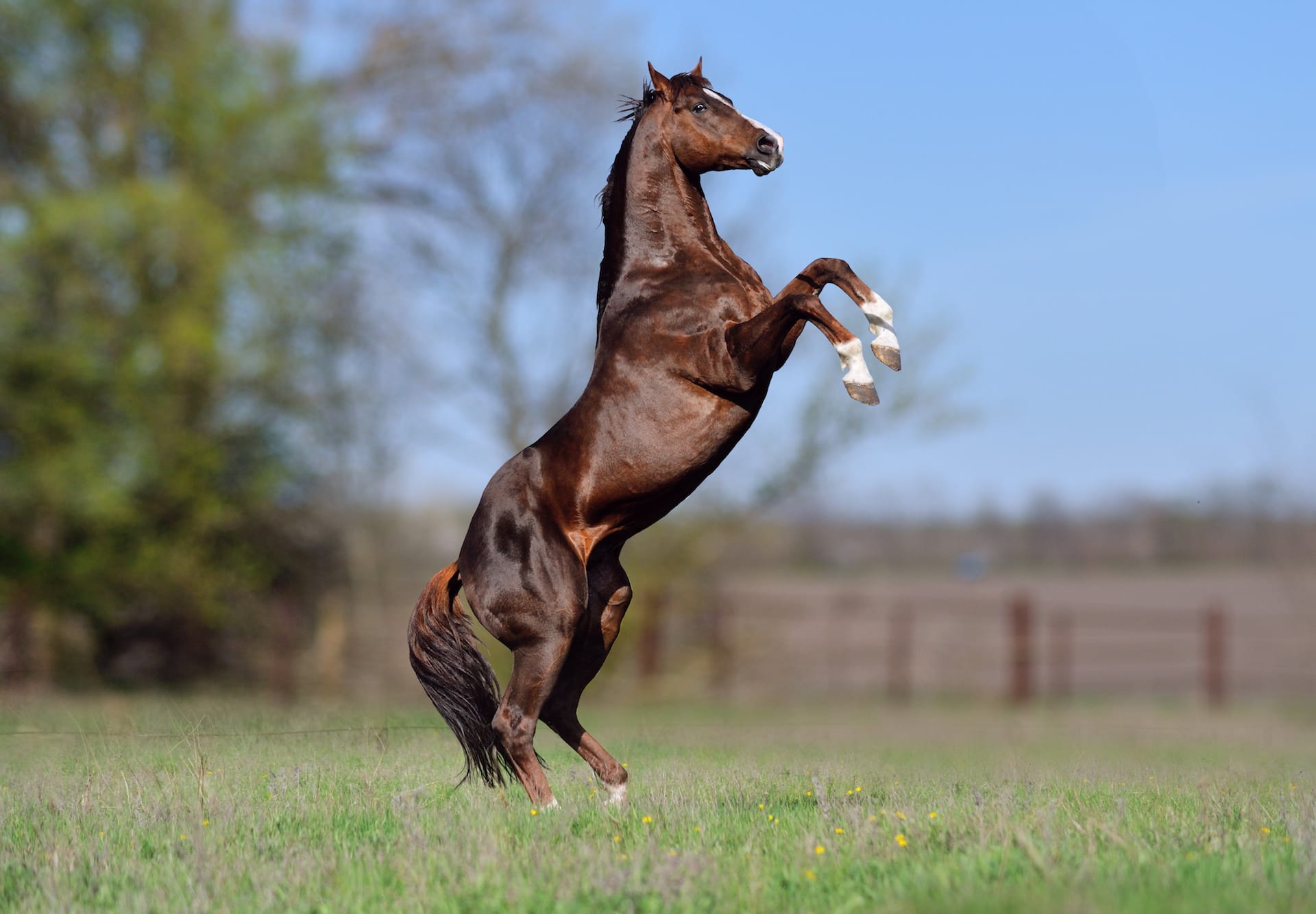The Thoroughbred has been bred for speed and endurance, with no other breed capable of matching their performance in both attributes. Bred from native mares and three stallions of Arabian, Barb and Turkish stock, the Thoroughbred is a breed with native and exotic origins. They are known for being hot-tempered and competitive, intelligent, bold and lively.
The breed can be divided into three types of horse; the sprinters, stayers and middle-distance horses, each of which have different characteristics. The sprinter tends to be taller, with a longer body and a notable speed advantage over the rest of the breed. The stayers tend to be smaller, and stockier, with an unmatched endurance. The middle-distance horses are a mix of both characteristics and can be well suited to cross-country eventing.
Across the breed, the notable characteristics are the prominent withers, the high and wide chest and the muscular, sloped shoulders. The legs are typically long, with large and powerful joints.
The Thoroughbred comes in a variety of colours. It is commonly seen in bay, dark bay, chestnut, black, or grey colouration. Rarely, you see roans with white facial markings.
Pet Profile
The ideal horse for racing, the Thoroughbred displays a competitive nature and athletic physique.
- Size: 15-17 hands at the withers (or 60-68 inches)
- Weight: 450-600kg
- Life expectancy: 20-30 years, but with good health and care, can live for much longer.
Exercise and nutrition
English Thoroughbreds are horses bred for sport and are athletic and energetic. They can be highly strung and quite a handful, so not good horses for beginners!
As a minimum, thoroughbreds will need 45 minutes to 1.5hrs exercise per day which could be schooling in an arena or riding out. However, their needs will vary depending on what they are training for and the needs of the individual horse.
As a general rule, a docile horse is a well-exercised horse, but talk to an experienced trainer in order to develop an exercise plan for your horse, based on your ambitions and your horse’s needs.
Feeding a Thoroughbred optimally for their lifestyle is an art and a science. The breed requires far more feed than other breeds just to maintain its weight and muscle bulk. In general a balanced mix between hay or grass, high fibre food with added oils along with nutritional supplements, typically fed 3 times a day might be appropriate. However, a horse’s nutritional needs will vary according to the work they are doing and their individual temperament.
In retirement feeding plans will need to change again, so whatever you are doing with your thoroughbred it is best advice to talk to both your vet and an experienced trainer in order to develop a meal plan for your horse.
Common health problems and illnesses
Exercise-induced Pulmonary Hemorrhage (EIPH) occurs when blood is present in the airways and lungs during and after exercise.
It occurs in almost all Thoroughbreds, and in severe cases can be spotted by the presence of blood at the nostrils (epistaxis). This condition, in severe cases, will hinder the horse’s performance, as well as shorten their racing career.
This condition can be diagnosed through several methods, such as an endoscopy, Bronchoalveolar lavage and cytopathology.
This condition can be managed via several pharmacological means depending on trigger factors. Talk to your vet for further information about EIPH, as well as the diagnosis and treatment of the condition.
Laminitis is a painful disease that has the potential to permanently cripple horses of all sizes. It occurs when the blood flow to the laminae (the inner layers of the hooves) is disrupted, causing inflammation and swelling, as well as severe pain. The laminae become permanently damaged due to the restricted blood flow, and unless the cause is addressed and treatment is begun immediately, the laminae will begin to die.
The laminae play a key role in the stability of the hoof, and in extreme cases the degeneration of the laminae will cause the pedal bone to sink through the sole of the foot. In most cases, by this stage the damage is irreversible.
The causes of laminitis are extremely numerous, and include, but are not limited to, stress, infection, obesity, Cushing’s disease or excessive and prolonged concussion of the hoof on hard ground.
Warning signs of laminitis include noticeable discomfort when walking (potentially causing the horse to lie down rather than stand), visible lameness, increased pulse in the foot, and in some cases a tendency to lean back on the hind feet in order to relieve pressure on the front feet.
In advanced conditions, watch out for the heel of the hoof growing faster than the toe, as well as the widening of the white line in the hoof wall.
If you notice any signs of laminitis, it is crucial that you call a vet immediately for proper diagnosis and treatment. This needs to be done as soon as possible to prevent as much permanent damage as possible.
Please consult your vet for further advice on the causes and prevention of laminitis.
Fun facts
- All English Thoroughbreds can trace their lineage to one of three Stallions - the Darley Arabian, the Godolphin Barb, and the Byerly Turk.
- Thoroughbreds are one of the fastest animals in the world, having been clocked going at just over 40 miles per hour!
- The prices of some top flat racing Thoroughbreds can extend to over £1million!
- Thoroughbreds are not just for racing. Many excel in dressage, show-jumping and eventing.

